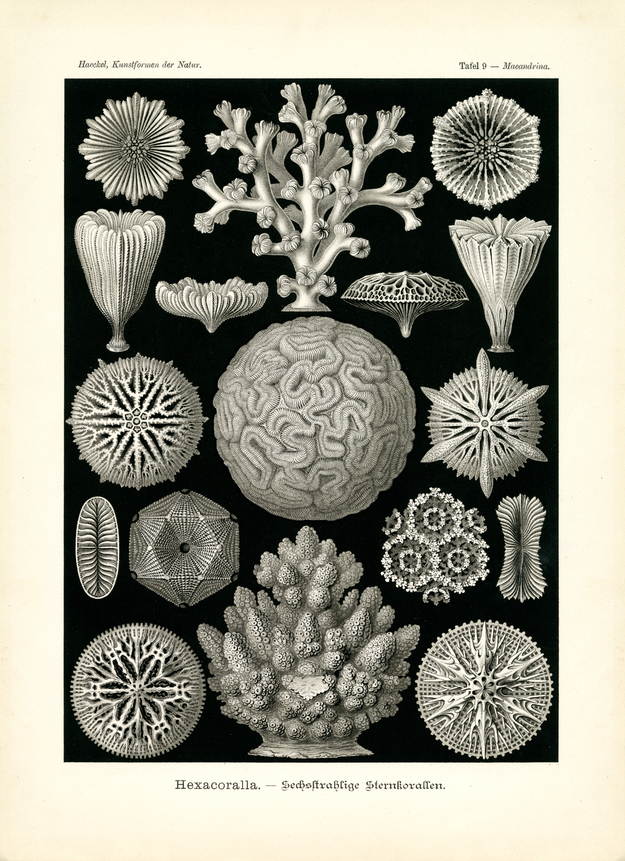Hexacoralla form a diverse order in the huge subclass of corals, all of which live in the ocean. The plate presents a range of such Hexacoralla, in fact, only the internal, solid lime frame, the white skeleton. The fleshy coat that covers this skeleton in the living coral has been removed. Like other Anthozoa Hexacoralla live at times single, in the form of isolated personae, at times united in colonies or Corma. In this case the individual persona has the geometric basic form of a regular six-edged pyramid; its hexagonal base is illustrated in fig. 2, 3, 6, 7, 14, 15. The mouth is located in the centre, leading through the gullet into the stomach cavity. From this cavity six ‘stomach-bags’ spread, repeatedly separated with the help of radial diaphragms or Septae; their arrangement and composition is, when seen in detail, very manifold. In general we differentiate six bigger jets of a first order (main jets or Perradia) and six smaller ones of second order (intermediate jets or Interradia). In the centre in between the two lie twelve weaker jets of a third order (ancillary jets or Adradia). Frequently, in between the latter and the former another 24 jets of a fourth order (sub-jets or Subradia) can be found. In the lateral view the individual Corolla persona appears at times flat, disc-shaped (fig. 2a, 14a), at times high, cup-shaped (fig. 4,5). With the help of the lower pole of the vertical main axis that lies opposite to the mouth opening the persona or the polyp is usually grown onto the ocean floor.
Colonies or Corma of Hexacoralla, usually composed of very numerous, closely connected personae (or polyps), grow out of an originally simple persona through repeated budding or incomplete division. Its nutrition is based on a perfect communism; since all food that the individual persona takes in through its mouth and digests in its stomach pit, moves from there into narrow tubes or ‘food-ducts’ (Gastro-ducts) that permeate the whole colony. Shape and size of these coral colonies differs considerably; at times they are branched like a tree (fig. 1), at times shrub-shaped (fig. 9), at times grass-like or even globose (fig. 8). Individual personae sit on the colonies (like flowers) at times far apart (fig. 1), at times closely together (fig. 9, 13); they often flow in series forming long, narrow valleys (fig. 8).
Due to their development on a massive scale in tropical oceans calcified Hexacoralla build numerous islands (atolls, coastal reefs, etc.). Even in calcified form these reefs of earlier periods of the history of the earth are well preserved, many a times so beautiful that all details of their delicate skeletal structure is just as well perceivable as in living animals. Huge rock mass is predominantly composed of fossil Hexacoralla, as for example in the well known “coral lime” in the upper (white) Jura mountains.
Translation of the original German introduction by Ernst Haeckel:
Phylum of Cnidaria (Nesseltiere); - subclass of Anthozoa (Korallen); - legion of Zoantharia (Sternkorallen); - order of Hexacoralla (sechsstrahlige Sternkorallen).
The illustrations of this plate exclusively present the solid internal lime frames of the Hexacoralla or ‘Flower-polyps’, the living soft parts have been removed. Most illustrations show individual personae; only fig. 1, 8 and 9 present colonies or Corma that are composed of many individual personae or polyps; fig. 12 and 13 show small parts of Corma.
Translation by VR Translators Bangalore
This is one of the 100 pop science biology illustrations that were published from 1899 – 1904 in Leipzig by Ernst Haeckel through Verlag des Bibliographischen Instituts.
We've scanned the original lithography at 1200dpi on the Epson A3 scanner of A3 scanner huren. You can download a 400dpi JPEG here. If you need the original high resolution TIFF file, please contact us at info@mediamatic.net
